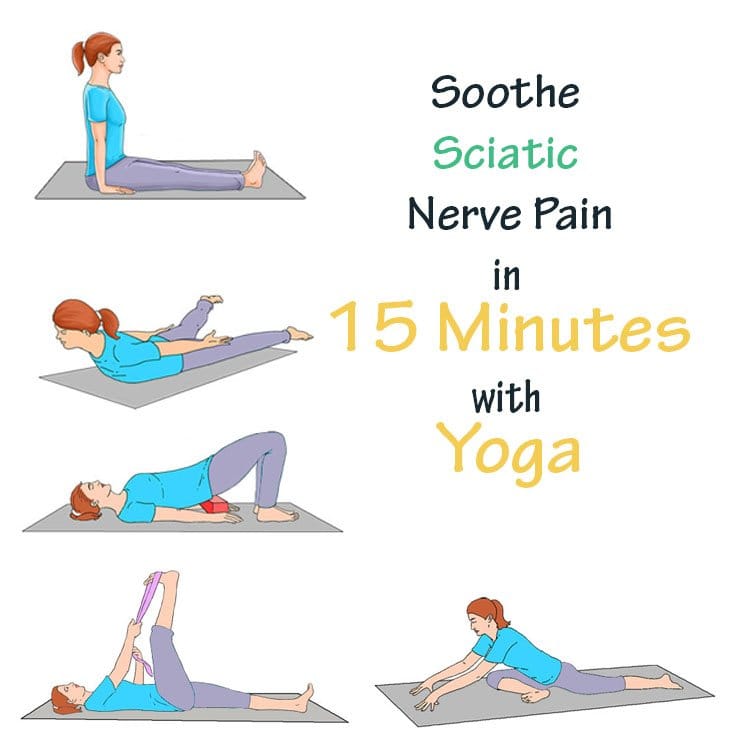Can you use yoga for sciatica? The Health Science Journal takes another look at sciatic nerve pain, this time through the lenses of yoga. We’ll learn how to soothe sciatic nerve pain with some classic yoga poses like the pigeon pose, the locust pose, the staff pose and many more.
The history of sciatica is long and painful. Even as early as the 5th century BCE, doctors and sufferers alike have tried a host of imaginative remedies, from leeches and hot coals in Roman times to 20th-century use of creams and injections. The principle causes of sciatic pain have been known for a while now, yet there are still millions who suffer from it. In 2005, the Journal of Neurosurgery: Spine estimated that more than 5% of the adult population in the United States suffers from sciatica, and over a lifetime, an individual has a 40% probability of experiencing it.
The pain associated with sciatica is one of the most intense and unpleasant pains a person can experience. When the pain occurs people have problems standing straight and the situation only gets worse when they decide to sit down.
Most of the symptoms appear on the right or left side of the lower back and affect the buttocks and legs and in many cases in the feet too. There are some individuals who witness a burning sensation in one of the legs or buttocks while the rest of the areas feel numb. In most cases, the affected leg feels weak and cold.
Numb thighs and buttocks, weakness in one of the legs or lower back area, tingling and/or burning sensation in the feet and legs and having problems to manage bowel and bladder work are some other symptoms associated with sciatica pain.
In addition, some health issues have impact on the state of your sciatica nerve. Some of these conditions include: spinal stenosis, spinal disorders like spondylitis, cracked or damaged disc, disc diseases and lower back trauma. Furthermore, your sciatica condition can be worsened by your lifestyle.
While it is true that some people have more problems with this condition than the other, it is also true that if we don’t treat this condition the situation will get worse over time.
When Does the Pain Occur?
Most commonly the pain starts slowly and then gradually increases. The symptoms are felt more at night or when coughing, sneezing or laughing. Additionally, pain can be felt when during prolonged walks, when standing or sitting for a longer time or staying in a bend forward or backward position for more than a few moments.
In order to treat your sciatic nerve pain, you can choose between a plethora of pharmaceutical medications and conventional therapies. However, experienced physicians also advise people to perform some type of physical activity together with their conventional therapy, like stretching for example.
Yoga as a Sciatica Pain Relief Technique
9 years ago, The Alternative Therapies in Health and Medicine revealed a scientific study in which individuals experiencing moderate to intense back pain who practiced a combination of yoga and standard therapies (using medications) have witnessed a drastic ease in the frequency and intensity of sciatica pain.
If the cause of your sciatic pain is a herniated or bulging disk, yoga that progresses from gentle poses to basic foundational standing poses and downward-facing dog will align, lengthen, and strengthen your lower back. A herniated disk does not always require surgery, and yoga can help you manage and lessen the harms caused by the herniation, oftentimes even reducing the herniation itself. Nevertheless, it’s important to check with your doctor about the severity of the herniation: in some cases surgery may be required.
If the cause of your sciatic pain is pressure on the nerve due to a short, tight piriformis, focus on stretching this muscle. Your approach should be gentle and progressive, since overworking the piriformis may lead to spasms and deep buttock pain, which may or may not be accompanied by sciatic pain.
NOTE: Consult with your doctor before performing any type of exercise!
Yoga for Sciatica
Staff Pose or Dandasana
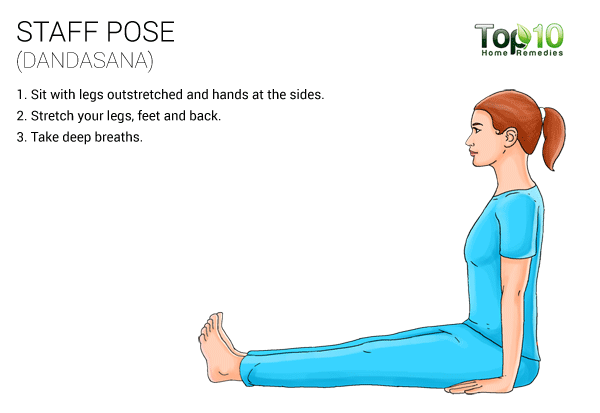
This is a basic sitting position in yoga which will stretch and relax the legs, activate the lower back, improve blood flow in the afflicted areas and bring positive effects to the sciatic nerve.
- Sit on a mat with your legs stretched in front of your body, keeping the hands at the sides. The palms are pressed on the floor;
- Try to flex the feet forward and stretch the legs at the same time;
- Bring the back up and stretch the spine as much as you can;
- Remain in this position for up to 30 seconds and don’t forget to make deep breaths.
Relax for a few seconds and perform this exercise for up to 10 times.
Locust Pose or Shalabhasana
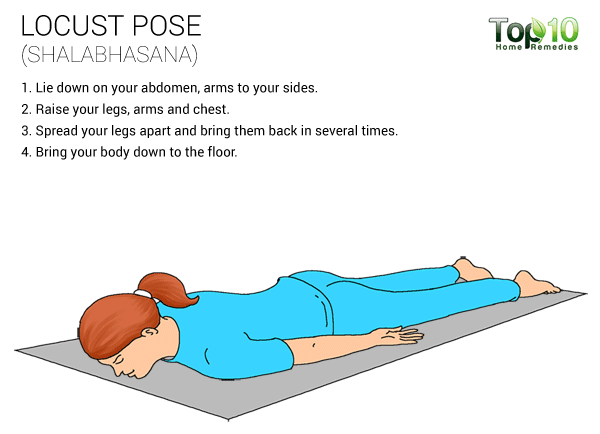
This pose supports the lower back and boosts blood flow to the hips. As it happens, sciatica pain can sometimes be triggered by improper blood flow. If the circulation is not good, you can experience pressure in different body parts that can trigger sciatica pain. Enhanced blood circulation will encourage healing and support sciatica pain relief.
- Lie down with your face positioned to the ground. Put the arms at your sides and keep the palms outwards. The toes must be positioned downward and they must touch each other. Keep the heels apart;
- Touch the ground with the chin; keep the neck elongated and the pubic bone pressed down;
- Inhale deeply and lift the legs, chest and arms up at once. Raise your knees off the floor, place your shoulders close to each other and keep the neck straight. When you feel that you have reached the highest position, breathe out and remain in this position for 8 seconds. Try to stretch the back carefully;
- Maintaining the position, breathe in and spread the legs away from each other, breathe out and bring them together. You can do around 5 reps, depending on your condition. People use this pose to support the regular locust pose and it has a good track record in reducing sciatic pain;
- Carefully bring yourself to the initial position. Keep the hand under the forehead and take a rest for 60 seconds.
Perform this exercise between 5 and 10 times.
Supported Bridge Pose or Setu Bandhasana

Here’s another exercise that is ideal for the buttocks and a great option for those dealing with sciatic pain.
- Lie on the ground on the back, gently bent the knees and put the feet on the floor;
- Bring back the heels towards the buttocks and put the arms and palms down parallel to the body;
- Apply some pressure on the ground with the help of the palms and feet as a form of support; inhale deeply and slowly raise the hips off the floor. At the same time push the tailbone up in the direction of the pubic bone. Keep the neck, shoulders and head on the ground while the lower back must be elongated and the knees must be placed apart;
- Remain in this position for about 15 seconds, breathe out and put your body down.
Perform this exercise for up to 10 times.
Pigeon Pose or Kapotasana
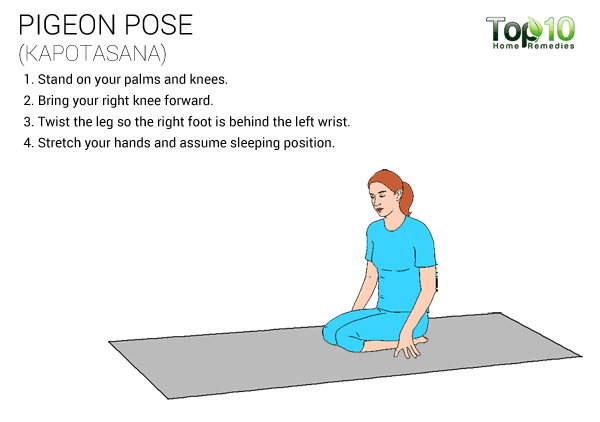
In some cases, sciatic pain comes as a result of certain pressure and irritation on the nerve that pushes it against the tendons found right beneath it. This results in a shooting leg and buttock pain. The pigeon pose is an excellent pose that stretches the piriformis and relieves the pressure on the sciatic nerve.
- With palms flat on the ground, fingers facing forward, and knees bent on the ground with your legs behind the knees, lift yourself up on your palms and knees;
- Bring your right knee forward so it’s placed behind your right wrist, and your right foot is in front of your left wrist. Your shin should come at a 45-degree angle at this point; Continue by sliding your left leg back, and stretch your torso forward;
- This position is maintained for 5 seconds; next, inhale and stretch your hands out in front of you, bringing your forehead to the ground, almost like a sleeping position;
- Taking deep breaths, maintain this pose for 15 to 30 seconds. Make sure you are consciously pushing your left thigh toward the ground and drawing your stomach slightly in for balance;
- Lift your head up, pull your hands back, tuck your left toes in and pull your right leg back;
- Repeat these steps with your left leg.
Repeat this exercise 5 to 10 times, alternating between your right and left legs.
Lie Back Big Toe Pose or Supta Padangusthasana
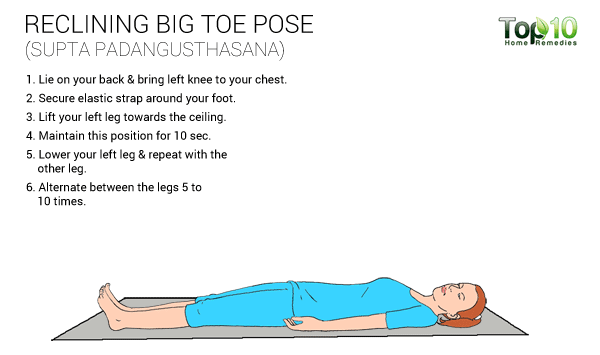
The Supta Padangusthasana supports blood flow in the affected areas:
- Lie on the ground with a flattened back and bend the left knee. Pull it toward the chest;
- Take an elastic strap and wrap it around the ball of the foot and raise your left leg up;
- While keeping your foot open and flexed stretch your leg and your buttocks pressed to the ground;
- Inhale deeply and keep this position for about 10 seconds;
- Lower your right knee back toward your chest before placing your right leg back on the ground.
Repeat the exercise with the right leg. Alternate between the legs 5 to 10 times.
Spinal Twisting Pose or Ardha Matsyendrasana
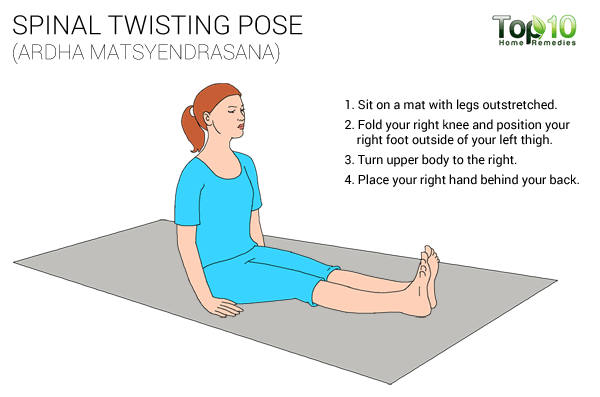
Our last exercise aims to help you get rid of pain and tension in your back and further boost blood circulation.
- Sit on the mat, stretch your legs and put the arms by your sides;
- Bend your right knee, position your right foot outside of your left thigh and hold your right toe with your left hand;
- Place your right hand behind your back, and put your upper body to the right, take deep breaths;
- Maintain this position for 30 to 60 seconds, reverse the legs and repeat the exercise.
Source: Top 10 Home Remedies


